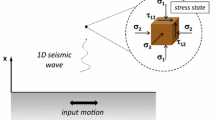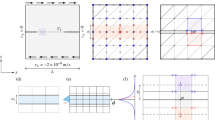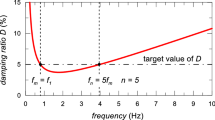Abstract
This study examines the applicability of the spectral cell method (SCM) to compute the nonlinear earthquake response of complex basins. SCM combines fictitious-domain concepts with the spectral-version of the finite element method to solve the wave equations in heterogeneous geophysical domains. Nonlinear behavior is considered by implementing the Mohr–Coulomb and Drucker–Prager yielding criteria. We illustrate the performance of SCM with numerical examples of nonlinear basins exhibiting physically and computationally challenging conditions. The numerical experiments are benchmarked with results from overkill solutions, and using MIDAS GTS NX, a finite element software for geotechnical applications. Our findings show good agreement between the two sets of results. Traditional spectral elements implementations allow points per wavelength as low as PPW = 4.5 for high-order polynomials. Our findings show that in the presence of nonlinearity, high-order polynomials (\(p \ge 3\)) require mesh resolutions above of \(PPW \ge \)10 to ensure displacement errors below 10%.




















Similar content being viewed by others
References
Abedian A, Parvizian J, Düster A, Rank E (2013) The finite cell method for the J2 flow theory of plasticity. Finite Elem Anal Des 69:37–47
Abedian A, Parvizian J, Düster A, Rank E (2014) Finite cell method compared to h-version finite element method for elasto-plastic problems. Appl Math Mech (English Edition) 10(35):1239–1248
Ainsworth M, Wajid HA (2009) Dispersive and dissipative behavior of the spectral element method. SIAM J Numer Anal 47(5):3910–3937
Bao H, Bielak J, Ghattas O, Kallivokas LF, O’Hallaron DR, Shewchuk JR, Xu J (1998) Large-scale simulation of elastic wave propagation in heterogeneous media on parallel computers. Comput Methods Appl Mech Eng 152:85–102
Bielak J, Ghattas O, Kim EJ (2005) Parallel octree-based finite element method for large-scale earthquake ground motion simulation. Comput Model Eng Sci 10(2):99–112
Borja RI, Amies AP (1994) Multiaxial cyclic plasticity model for clays. J Geotech Eng 120(6):1051–1070
Borja RI, Lin C-H, Sama KM, Masada GM (2000) Modelling non-linear ground response of non-liquefiable soils. Earthq Eng Struct Dyn 29(1):63–83
Casarotti E, Stupazzini M, Lee SJ, Komatitsch D, Piersanti A, Tromp J (2008) CUBIT and seismic wave propagation based upon the spectral-element method: an advanced unstructured mesher for complex 3D geological media. In: Proceedings of the 16th international meshing roundtable, Springer, pp 579–597
Chaboche J-L (1989) Constitutive equations for cyclic plasticity and cyclic viscoplasticity. Int J Plast 5(3):247–302
Cook RD, Malkus DS, Plesha ME (1989) Concepts and applications of finite element analysis. Wiley, New York
Cupillard P, Delavaud E, Burgos G, Festa G, Vilotte J-P, Capdeville Y, Montagner J-P (2012) RegSEM: a versatile code based on the spectral element method to compute seismic wave propagation at the regional scale. Geophys J Int 188(3):1203–1220
Dafalias YF, Herrmann LR (1980) A bounding surface soil plasticity model. Soils Under Cycl Transient Load 1:335–346
de Souza Neto EA, Perić D, Owen DRJ (2008) Computational methods for plasticity. Wiley, New York
Duczek S, Joulaian M, Düster A, Gabbert U (2014a) Numerical analysis of Lamb waves using the finite and spectral cell methods. Int J Numer Methods Eng 99(1):26–53
Duczek S, Liefold S, Gabbert U (2014b) The finite and spectral cell methods for smart structure applications: transient analysis. Acta Mech 226:1–25
Duczek S, Liefold S, Gabbert U (2014c) The spectral cell method for ultrasonic guided wave propagation problems. In: EWSHM-7th European workshop on structural health monitoring
DuRoss CB (2008) Holocene vertical displacement on the central segments of the Wasatch fault zone, Utah. Bull Seismol Soc Am 98(6):2918–2933
Düster A, Parvizian J, Yang Z, Rank E (2008) The finite cell method for three-dimensional problems of solid mechanics. Comput Methods Appl Mech Eng 197(45):3768–3782
Elgamal A, Yang Z, Parra E, Ragheb A (2003) Modeling of cyclic mobility in saturated cohesionless soils. Int J Plast 19(6):883–905
Field E, Kramer S, Elgamal A-W, Bray J, Matasovic N, Johnson P, Cramer C, Roblee C, Wald D, Bonilla L et al (1998) Nonlinear site response: where we’re at (a report from a scec/peer seminar and workshop). Seismol Res Lett 69(3):230–234
Frankel A (1993) Three-dimensional simulations of ground motions in the San Bernardino Valley, California, for hypothetical earthquakes on the San Andreas fault. Bull Seismol Soc Am 83(4):1020–1041
Graves RW, Pitarka A (2010) Broadband ground-motion simulation using a hybrid approach. Bull Seismol Soc Am 100(5A):2095–2123
Hashash YM, Phillips C, Groholski DR (2010) Recent advances in non-linear site response analysis. In: Proceedings of the 5th international conference in recent advances in geotechnical earthquake engineering and soil dynamics
Hinton E, Rock T, Zienkiewicz O (1976) A note on mass lumping and related processes in the finite element method. Earthq Eng Struct Dyn 4(3):245–249
Jeremić B, Cheng Z, Taiebat M, Dafalias Y (2008) Numerical simulation of fully saturated porous materials. Int J Numer Anal Methods Geomech 32(13):1635–1660
Joulaian M, Duczek S, Gabbert U, Düster A (2014) Finite and spectral cell method for wave propagation in heterogeneous materials. Comput Mech 54(3):661–675
Komatitsch D, Tromp J (2002a) Spectral-element simulations of global seismic wave propagation-I. Validation. Geophys J Int 149(2):390–412
Komatitsch D, Tromp J (2002b) Spectral-element simulations of global seismic wave propagation-II. Three-dimensional models, oceans, rotation and self-gravitation. Geophys J Int 150(1):303–318
Komatitsch D, Vilotte J-P (1998) The spectral element method: an efficient tool to simulate the seismic response of 2D and 3D geological structures. Bull Seismol Soc Am 88(2):368–392
Magistrale H, Olsen K, Pechmann J (2008) Construction and verification of a Wasatch Front community velocity model: collaborative research with San Diego State University and the University of Utah. US Geological Survey Final Technical Report, Submitted to NEHRP
Manzari MT, Dafalias YF (1997) A critical state two-surface plasticity model for sands. Geotechnique 47(2):255–272
Midas-GTS-NX (2016) version 1.1 (April 6). MIDAS Information Technology, Seongnam, South Korea. http://midasgtsnx.com
Moczo P, Kristek J, Galis M, Pazak P, Balazovjech M (2007) The finite-difference and finite-element modeling of seismic wave propagation and earthquake motion. Acta Phys Slov 57(2):177–406
Olsen KB, Archuleta RJ (1996) Three-dimensional simulation of earthquakes on the Los Angeles fault system. Bull Seismol Soc Am 86(3):575–596
Parvizian J, Düster A, Rank E (2007) Finite cell method. Comput Mech 41(1):121–133
Pelties C, Käser M, Hermann V, Castro CE (2010) Regular versus irregular meshing for complicated models and their effect on synthetic seismograms. Geophys J Int 183(2):1031–1051
Prevost JH (1985) A simple plasticity theory for frictional cohesionless soils. Int J Soil Dyn Earthq Eng 4(1):9–17
Restrepo D, Taborda R, Bielak J (2011) Effects of soil nonlinearity on ground response in 3D simulations—an application to the Salt Lake City basin. In: Proceedings of the 4th IASPEI/IAEE international symposium: effects of surface geology on seismic motion, University of California, Santa Barbara, August 23–26
Ruess M, Tal D, Trabelsi N, Yosibash Z, Rank E (2012) The finite cell method for bone simulations: verification and validation. Biomech Model Mechanobiol 11(3–4):425–437
Saul’ev VK (1963) On solution of some boundary value problems on high performance computers by fictitious domain method. Sib Math J 4(4):912–925 (in Russian)
Schillinger D, Ruess M, Zander N, Bazilevs Y, Düster A, Rank E (2012) Small and large deformation analysis with the p-and B-spline versions of the finite cell method. Comput Mech 50(4):445–478
Seed HB, Idriss IM (1969) Influence of soil conditions on ground motions during earthquakes. J Soil Mech Found Div 95(1):99–138
Seed HB, Idriss IM (1970) Soil moduli and damping factors for dynamic analyses. EERC Report No. 10-10. Technical report, Earthquake Engineering Research Center, University of California, Berkeley, CA
Seriani G, Priolo E (1994) Spectral element method for acoustic wave simulation in heterogeneous media. Finite Elem Anal Des 16(3–4):337–348
Simo JC, Hughes TJR (1998) Integration algorithms for plasticity and viscoplasticity In: Marsden JE, Wiggins S, Sirovich L (eds) Computational inelasticity, volume 7 of interdisciplinary applied mathematics. Springer, New York
Stupazzini M, Paolucci R, Igel H (2009) Near-fault earthquake ground-motion simulation in the Grenoble Valley by a high-performance spectral element code. Bull Seismol Soc Am 99(1):286–301
Szabo BA, Babuška I (1991) Finite element analysis. Wiley, New York
Taborda R, Bielak J (2013) Ground-motion simulation and validation of the 2008 Chino Hills, California, Earthquakes. Bull Seismol Soc Am 103(1):131–156
Taborda R, Bielak J, Restrepo D (2012) Earthquake ground-motion simulation including nonlinear soil effects under idealized conditions with application to two case studies. Seismol Res Lett 83(6):1047–1060
Tu T, Yu H, Ramirez-Guzman L, Bielak J, Ghattas O, Ma K-L, O’Hallaron DR (2006) From mesh generation to scientific visualization: an end-to-end approach to parallel supercomputing. In: Proceedings of the 2006 ACM/IEEE conference on supercomputing, ACM, p 91
Xu J, Bielak J, Ghattas O, Wang J (2003) Three-dimensional nonlinear seismic ground motion modeling in basins. Phys Earth Planet Inter 137:81–95
Acknowledgements
The authors are thankful to Universidad EAFIT for the institutional and financial support given to this project. Some of the computations were performed on Apolo in the Center of Computer Science at Universidad EAFIT, and on Blue Waters at the National Center for Supercomputing Applications (NCSA). Blue Waters is a joint effort of the University of Illinois at Urbana-Champaign and is supported by the state of Illinois and the U.S. National Science Foundation (NSF) (awards OCI-0725070 and ACI-1238993). This work was also part of NSF PRAC awards: Extending the Spatiotemporal Scales of Physics-Based Seismic Hazard Analysis (ACI-1440085), and Improving Earthquake Forecasting and Seismic Hazard Analysis Through Extreme-Scale Simulations (ACI-1713792). The SCEC contribution number for this paper is 7283. We also thank two anonymous reviewers, and Assistant Professor Ricardo Taborda from the Center for Earthquake Research and Information (CERI) at the University of Memphis, for their helpful comments, suggestions, and careful reading of our work.
Author information
Authors and Affiliations
Corresponding author
Rights and permissions
About this article
Cite this article
Giraldo, D., Restrepo, D. The spectral cell method in nonlinear earthquake modeling. Comput Mech 60, 883–903 (2017). https://doi.org/10.1007/s00466-017-1454-8
Received:
Accepted:
Published:
Issue Date:
DOI: https://doi.org/10.1007/s00466-017-1454-8




